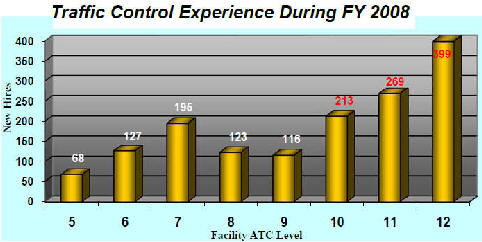 |
|
|
|
|
|
|||
|
By Mike Mitchell |
||||
 |
April 6, 2010 - The Department of Transportation’s (DOT) Office of Inspector General issued their report on the Federal Aviation Administration’s (FAA's) policies and procedures for screening, placing, and initially training newly hired air traffic controllers.
DOT found that the
FAA’s process for selecting and placing new controllers does not
sufficiently evaluate candidates’ aptitudes because the FAA does not
effectively use screening test results or consider candidates’ FAA
Academy performance to help determine facility placement. |
|||
|
DOT conducted
this review at the request of the Chairman of the House Subcommittee
on Aviation. Their audit
objectives were to: (1) evaluate how FAA determines whether
candidates have the requisite abilities to become successful
controllers; (2) determine what procedures FAA uses to place
controllers at air traffic facilities; and (3) assess whether the
initial training provided by the FAA Academy adequately prepares new
controllers for facility on-the-job training.
As a result, new controller candidates, many of which have no prior air
traffic control experience are being assigned to some of the busiest air
traffic control facilities with little consideration of whether they
have the knowledge, skills, and abilities necessary to become certified
controllers at those locations.
DOT recommended that FAA evaluate and redesign its current screening
test to consider candidates’ skill sets, assign candidates to a facility
based on their Academy performance, and improve its Academy training
program by implementing the recommendations of FAA’s 2007 Controller
Training and Development Group.
The FAA partially concurred but proposed acceptable corrective actions
to all of DOT recommendations.
Background; after the 1981
controller strike, FAA screened candidates primarily using a 9-week
training course taught at the |
||||
|
However, this
process was expensive, costing about $20,000 per candidate, so the FAA
began developing AT-SAT in the 1990s to achieve a less costly and more
streamlined screening tool to identify candidates with the best
controller aptitudes.
In designing
AT-SAT, FAA scientists performed a detailed analysis to identify the
specific tasks that controllers must complete and measure the skills
that support those tasks. Currently, FAA employs the following
three-step indoctrination process for newly hired air traffic controller
candidates:
• Screening:
AT-SAT consists of an 8-hour series of aptitude tests. Controller
candidates with no previous air traffic control experience and those who
have graduated from a Collegiate Training Initiative program are
screened using AT-SAT.1Candidates must score at least 70 percent on the
exam to be considered for employment. Controller candidates with prior
air traffic control experience, such as ex-military controllers, are
exempt from taking AT-SAT.
• Placement: After
completing screening, new candidates are assigned to a facility
location. This is done by creating a list of facility vacancies and
eligible applicants. A group of air traffic facility managers then meets
at least once a quarter and attempts to match the assignment preference
of each candidate to the needs of specific air traffic control
facilities. Air traffic control facilities are categorized by levels (4
through 12) based on the complexity and number of operations. Level 4
facilities are the least complex while Level 12 are the most complex.
Controllers’ base salaries are determined by the level of the air
traffic control facility to which they are assigned.
• Initial
Training: Before they begin training at their assigned facilities, most
new controllers must complete 2 to 3 months of initial training at the
The FAA does not
use AT-SAT results to determine the level of facility in which new
controllers are placed even though the number of inexperienced
controller candidates being hired and screened by AT-SAT is increasing.
For example, the number of new hires with no prior air traffic control
experience increased from 7 percent of those hired in fiscal year (FY)
2007 to approximately 72 percent during the first half of FY 2009. |
| ©AvStop
Online Magazine
Contact
Us
Return To News
|
|
